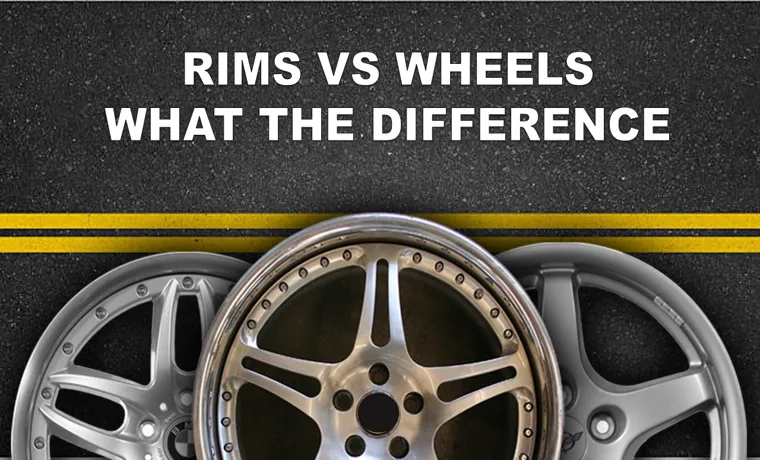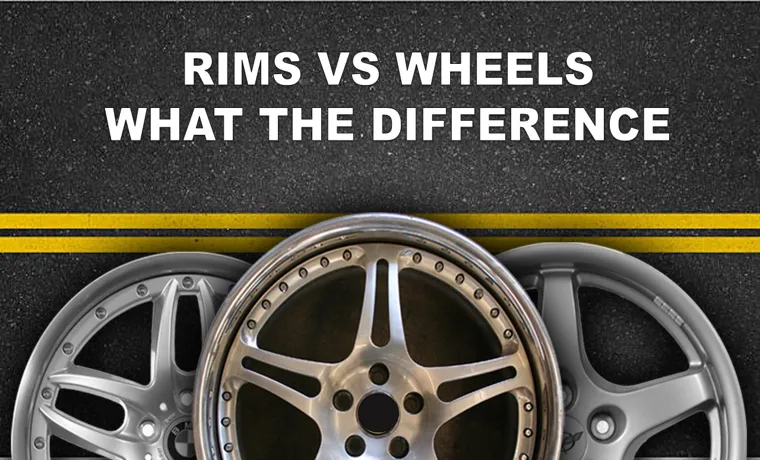Have you ever been confused about the difference between a wheel and a tire? It’s a common misconception that these two terms refer to the same thing. However, the truth is that they are actually two distinctly different components of a vehicle. The wheel is the circular metal structure that attaches to the car’s axle and supports the tire.
It’s a critical part of the vehicle’s suspension system and ensures smooth driving on various terrains. The tire, on the other hand, is the rubber portion that comes into contact with the road and provides traction, absorbs shocks, and adds to the overall safety of the vehicle. Understanding the respective roles of a wheel and a tire can make a huge difference in improving your driving experience.
Whether you’re buying new wheels or choosing different tire sizes, this knowledge can come in handy when making the best decision for your car’s performance. In this blog post, we’ll dive deeper into the differences between a wheel and a tire, their functions, and how they work together to make your vehicle run efficiently. You’ll also get a better sense of what to look out for when choosing the right wheels and tires for your car, and what impact they can have on your overall driving experience.
So, let’s get started!
Table of Contents
Definition
Have you ever wondered about the difference between a wheel and a tire? Well, to put it simply, a wheel is a circular object that rotates on an axle and supports the weight of a vehicle, while a tire is a rubber covering that fits around the wheel and provides traction and shock absorption. Think of the wheel as the foundation and the tire as the exterior, both working together to create a safe and efficient ride. It’s important to note that not all wheels are made for all tires, as the size and shape can vary depending on the type of vehicle and terrain.
So next time you hit the road, take a moment to appreciate the teamwork between your wheels and tires.
Wheel
A wheel is a circular design that rotates around an axis, enabling motion and transportation. It is one of the greatest inventions in human history, and it remains a critical component in our lives, enabling us to travel, move heavy objects, and power various machinery. The wheel is made up of three basic parts: the hub, the rim, and the spokes.
The hub is located at the center of the wheel and attaches to the axle, which allows the entire structure to rotate. The rim resides on the outer edge of the wheel, and it is where the tire is mounted. The spokes are the connecting pieces that run from the hub to the rim, helping to support the weight of the wheel and distribute it evenly.
The history of the wheel is fascinating, as it has undergone many modifications and uses throughout time. From the pots and carts of ancient civilization to the modern automobile wheels, the wheel has come a long way, and its significance in our daily lives cannot be overstated.

Tire
A tire is a component of a vehicle that makes contact with the road surface and provides mainly the grip and support needed for the vehicle’s movement. It’s essentially a rubber cushion that surrounds a metal rim, which rotates on the wheel axle as the vehicle moves. Tires are classified according to vehicle types, tread patterns, and weather conditions.
They’re made up of several layers of synthetic and natural rubber components, which give them their durability and flexibility. Tires vary in size depending on the vehicle and its purpose, and they come in different price ranges. The quality of the rubber used, the tread pattern of the tire, and its size affect the tire’s performance.
For instance, a tire with a deeper tread pattern provides better grip on slippery surfaces, while a tire with a wider diameter is more stable and easier to handle. Therefore, when choosing a tire, it’s essential to consider all of these factors to ensure that your vehicle runs safely and efficiently.
Function
Have you ever wondered what the difference is between a wheel and a tire? Well, the function of each is quite different. A wheel is the circular metal structure that is attached to a car or any other moving vehicle’s axle, and it supports the weight of the vehicle. The tire, on the other hand, is made of rubber and fits around the wheel.
It is responsible for providing traction and cushioning the vehicle from bumps on the road. In simple terms, the wheel is the metal frame, while the tire is the rubber that covers the metal, allowing the vehicle to roll. As the tire rotates, it grips the road, enabling the car to move forward.
Additionally, tires come in different sizes and types depending on the vehicle’s purpose and intended use. So, the next time you hear the terms “wheel” and “tire,” remember that although they work together to support the vehicle’s movement, they have distinct functions.
Wheel
A wheel is an ingenious invention that has revolutionized transportation. Its primary function is to reduce friction when rolling, significantly reducing the effort required to move objects. It works by rotating around an axle, with the point of contact on the ground being the wheel’s rim.
The wheel’s design and materials have evolved over time, from wooden wheels to rubber tires in modern times. The function of a wheel has been useful in various fields, such as transportation, agriculture, manufacturing, and construction. Wheels have made it possible to move heavy objects with ease, enabling us to construct massive structures, travel across countries and continents, and even explore space.
The versatility and efficiency of wheels have made them an integral part of our lives and have enabled us to achieve feats that were once thought impossible.
Tire
A tire is an essential part of any vehicle as it provides the necessary grip and traction for safe and smooth driving. Apart from supporting the weight of the vehicle, a tire also plays a crucial role in maintaining stability and ensuring a comfortable ride. Its primary function is to grip the road surface to prevent slippage or skidding, especially on wet or slippery roads.
The tire’s tread pattern and depth are designed to maintain the necessary friction between the tire and the road surface. In addition to these functions, tires also absorb shock and road noise, providing a comfortable ride. The tire’s construction, including the materials used, size, and shape, also affect its performance and handling characteristics.
Overall, a tire plays a significant role in a vehicle’s safety, comfort, and handling, and it is crucial to choose the right tire type and size for your specific vehicle and driving needs. So, the next time you hit the road, remember to check your tires’ condition and ensure that they are in good shape for a safe and smooth ride.
Construction
Have you ever wondered what the difference is between a wheel and a tire? Well, the answer is actually quite simple. A wheel is the circular metal structure that the tire fits onto. It is often made of aluminum or steel and is designed to hold the tire in place while allowing it to rotate smoothly.
A tire, on the other hand, is the rubber outer layer that provides traction and absorbs shock as the vehicle moves. It is made up of several layers, including the tread, the sidewall, and the inner liner, and is designed to withstand the wear and tear of everyday use. So while the wheel and tire work together to make your vehicle move, they are two distinct components with different functions.
Next time you’re admiring your car, take a moment to appreciate both the wheel and tire for their respective roles in keeping you on the road.
Wheel
When it comes to constructing wheels, there are a few key components that are essential to making a strong and long-lasting wheel. The rim, spokes, and hub all work together to provide support, stability, and flexibility. The rim is the outer edge of the wheel that holds the tire in place and acts as a contact point for the brakes.
The spokes connect the rim to the hub, which is the central part of the wheel that houses the axle. The hub also contains bearings that allow the wheel to rotate smoothly. Each of these components needs to be carefully selected and fused together to create a well-built wheel that can withstand constant use and pressure.
One essential aspect of wheel construction is ensuring that all the components are properly aligned and balanced. A poorly constructed wheel can result in an uncomfortable ride, wobbling, or even lead to accidents. By using high-quality materials and paying attention to even the smallest details, wheel construction can result in a durable and reliable product that plays an essential role in transportation and a range of industries.
Tire
Tire construction is an intricate process that involves several layers of materials. The tire’s innermost layer, known as the liner, is made of butyl rubber and helps retain air pressure. The next layer, the carcass, consists of strong, flexible textile fibers that provide structural support.
The sidewalls are made of rubber compounds and are responsible for holding the tire onto the wheel. The crown, or tread area, is the part that makes contact with the road and is made from various rubber compounds that are selected based on their intended use. Finally, the bead is made from high-strength tempered steel wire and is what secures the tire onto the wheel.
Overall, tire construction is a precise process that requires attention to detail and the use of high-quality materials to ensure safety and durability on the road.
Interchangeability
Many people confuse the terms “wheel” and “tire,” but they are actually two separate components that work together to make a vehicle move. A wheel is the circular metal structure that attaches to the axel and provides support for the vehicle. A tire, on the other hand, is the rubber material that wraps around the wheel and provides contact with the road.
While wheels are designed to be interchangeable between vehicles, tires are not. Tires come in different sizes and shapes to fit specific wheel sizes, and each vehicle has unique tire requirements. This means that if you need to replace your tires, you’ll need to ensure that the new tires meet the manufacturer’s specifications for your vehicle.
So, while wheels and tires work together, they serve different functions, and it’s important to understand the difference between the two when it comes to vehicle maintenance.
Wheel
Interchangeability of wheels is a great aspect of today’s automobile industry. Gone are the days where one had to go to the manufacturer to get a spare wheel. With the introduction of interchangeable wheels, one can easily swap out a damaged wheel for a new one instead of waiting for a specific one to come in.
Interchangeable wheels also allow for greater customization and versatility. With the right offset and bolt pattern, one can fit a wide range of different wheels on their car and give it a unique and stylish look. The compatibility of wheels also extends to different makes and models of cars, meaning that a wheel from a Chevy can potentially be used on a Honda or Toyota with the right specifications.
The interchangeability of wheels has greatly benefited the automobile industry, making it easier and more convenient for owners to maintain their vehicles and experiment with different styles and designs.
Tire
When it comes to tires, interchangeability can be a confusing topic for many drivers. Simply put, interchangeability refers to the ability to use one tire size or type in place of another on a particular vehicle. While some tires are considered interchangeable, it’s important to note that not all tire sizes and types can be swapped out without issue.
For example, if your vehicle is designed for certain tire sizes, substituting a different size could affect your car’s handling, braking, and even its overall safety. In addition, it’s important to consider factors such as load capacity and speed ratings when choosing a tire, as these factors can also affect interchangeability. By understanding the limitations of tire interchangeability and consulting with a trusted tire dealer or mechanic, you can ensure that you’re choosing the right tires for your vehicle’s needs.
Takeaway
In summary, the difference between a wheel and a tire is that a wheel sits at the center of a vehicle and provides the surface for the tire to be mounted onto. A tire, on the other hand, is the rubber exterior that makes contact with the road. It is common for many people to use the terms interchangeably, but it’s important to understand the distinction, especially when purchasing replacements.
When replacing just the tire, it’s crucial to ensure you get the correct size and type for a safe and comfortable ride, and likewise, replacing just the wheel can impact factors like handling and performance. So, remember that while the wheel and the tire work in conjunction to make your vehicle go, they each have their own unique role.
Conclusion
In the simplest terms, a wheel is the hard-working foundation that supports your vehicle, while the tire is the stylish and sturdy outer layer that helps you grip the road. Much like yin and yang or peanut butter and jelly, a wheel and a tire are two essential parts that work together perfectly. So, the next time you’re cruising down the road, take a moment to appreciate the delicate dance between your trusty wheels and dependable tires that keep you moving smoothly towards your destination.
“
FAQs
What is a wheel?
A wheel is a circular object that rotates around an axle to facilitate movement or transportation.
What is a tire?
A tire is a rubber covering that fits around a wheel to provide friction and traction with the ground.
How is a wheel different from a tire?
A wheel refers to the circular object that rotates around an axle, while a tire is the rubber covering on the wheel that facilitates movement on the ground.
Can a vehicle run without tires?
No, a vehicle cannot run without tires as they provide the necessary friction and grip to move the vehicle forward.
Why do tires need to be replaced periodically?
Tires need to be replaced periodically as they undergo wear and tear due to constant usage, exposure to the elements, and changes in temperature. This can lead to reduced traction and safety concerns.
How do I know when to replace my tires?
You should replace your tires when the tread wears down to 2/32 of an inch or if you notice any cracks, bulges, or other signs of damage on the tire.
What are the different types of tires available in the market?
There are various types of tires available depending on the intended use, such as all-season tires, winter tires, summer tires, performance tires, and off-road tires.



